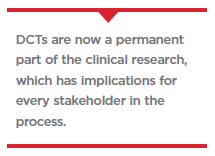 Global events often trigger cultural disruptions that forever change the way we work.
Global events often trigger cultural disruptions that forever change the way we work.
In World War II, Rosie the Riveter inspired 19 million women to enter the workforce to cover for the men at war. Economists thought it would be a temporary fix, but when the war ended women kept working, changing our economy forever.
9/11 made us rethink what safety looks like. This event led to changes in how we design public buildings, monitor streets, and scan travelers at airports. Those changes have become a lasting part of how we now move through the world.
COVID-19 is having a similar affect. Travel bans and work from home mandates taught us that people don’t really need to be face-to-face to be connected — even in clinical trials. It caused our industry to embrace many elements of decentralized clinical trials (DCTs), including telemedicine, home health visits, and direct-to-patient drug delivery.
And there’s no going back. DCTs are now a permanent part of the clinical research, which has implications for every stakeholder in the process.
Patients
Before COVID-19, if you wanted to participate in a clinical trial you had to travel to the research site. There were seldom virtual visit options and sponsors rarely offered alternatives to site visits when developing protocols.
Now patients see there are more ways to engage with the healthcare system as well as clinical research. They have seen their loved ones attend telehealth visits and receive home healthcare when going to the clinic wasn’t viable. They have become  more aware of clinical research, thanks to the rapid development of COVID-19 vaccines and the round-the-clock media coverage of those trials.
more aware of clinical research, thanks to the rapid development of COVID-19 vaccines and the round-the-clock media coverage of those trials.
That flow of information through familiar consumer sites made clinical research a part of the daily news cycle, educating consumers about trial participation in ways that bolstered awareness of trials and the potential benefits of participation.
The vaccine trials made clinical research more relatable for the average patient — and their experiences accessing healthcare during the pandemic made them more knowledgeable about what is possible. It changed the patient perspective, which is a good thing for everyone involved.
Going forward, when patients consider trial participation, they will expect to see virtual elements, and they will question whether every visit has to be at a clinic.
Future trial participants may not so willingly drive three hours twice a week to talk about their symptoms; or sit for long hours at a site to prove that they fasted before receiving medication. They will expect the trial design to be more respectful of their time, and if it is not, they may not participate.
Similarly, for patients being recruited by competing trials, the use of patient-centered virtual elements may sway their choice.
Sites
In many ways, the lingering effects of COVID-19 will likely have the biggest impact on research sites themselves.
When the pandemic caused site closures and the adoption of DCT elements, trial sites faced the greatest disruption. Almost overnight, and with little initial guidance, they had to adopt new technologies, change their workflows, and train their staff and patients to use new tools.
And they performed admirably. Site staffs across the globe embraced these changes to keep their patients safe and to maintain study continuity throughout the pandemic.
It was a difficult journey, but it opened sites to the idea that they can be innovative, rethinking how and where they provide care, and who they can reach. For sites willing to make these innovations part of the way they operate in the future, it may also give them a competitive advantage over their less adaptable peers.
Prior to the pandemic, many sites were hesitant to embrace DCTs, and their concerns were understandable. In many cases, using DTCs allow sponsors to run trials using fewer sites; and the addition of home health visits, drug delivery services, and the use of local labs, means payments will be spread across a broader group of stakeholders. It also means sites need to be familiar with telehealth and remote monitoring platforms, and to have the skills to leverage these technologies and train their peers.
It’s a big change for sites, but one with many silver linings. In DCTs, the in-person time investigators and staff do spend with patients is more meaningful. Instead of spending facetime collecting data that could be captured remotely, site visits are used to conduct treatment steps, educate patients, and talk to them about the treatment journey. It makes the best use of the investigator’s time, and it creates a more positive site experience for patients and site staff.
DCTs also allow investigators to oversee more patients from a single site. By minimizing the number of site visits, patients can live much further away and still be engaged with a site and its investigator. In an age of precision medicine and rare disease trials, this gives sites the opportunity to recruit the right patients from a broader and more diverse patient population. And for burgeoning sites that want to attract more trial opportunities, embracing DCT technology and partnerships may give them an edge over less-adaptable sites.
To be successful, investigators will have to adjust to the new economic value chain where other value-adding service providers, including home research nurses, IMP distribution, and technology providers are participating.
Pharma/Sponsors
The industry’s risk-averse mindset to technology adoption manifested itself in a slower, “wait-and-see" approach to DCT adoption. But the pandemic pushed sponsors out of that comfort zone, and they can’t put the genie back in the bottle.
The use of DCTs during the pandemic gave pharma an opportunity to prove that this approach to research works. It also gave them a new way to solve an old problem: how to lower the burden of participation and make trials more engaging and patient-centric.
The use of telehealth, wearable devices, home health visits, and drug delivery services all achieve the same goal — they make trials easier for patients. It also sends the message that sponsors appreciate and value the time patients invest in research. Additionally, with the increased DCT knowledge patients have gained during the pandemic, sponsors that factor patient convenience into every decision and incorporate DCT elements when possible could accelerate recruitment and improve retention, gaining an edge over their competing studies.
Now that sponsors know DCTs can work and regulators will support the data collected via these trial models, sponsors are expected to make DCTs a common part of their research portfolio. When speaking with leaders across our industry, I like to ask them a question: By 2022, what percent of trials will incorporate virtual trial elements? The most common prediction: 60%.
The key now is figuring out how to generate the most value from these research models. At the onset of the pandemic, sponsors had to shift course overnight, deploying the tools and technologies as a mitigation strategy to keep patients safe and research moving forward. These approaches proved not only safe and viable but also infused much needed patient-centricity into research, making it more friendly and accessible. Post-pandemic, sponsors need to more effectively factor the economic benefits of patient centricity into the study design.
Deciding to use telehealth visits, drug delivery services or other DCT elements, should be part of the earliest trial planning process, so these decisions can be linked to protocol designs, site selection, and recruiting goals. It also ensures that every decision is considered through the lens of the patient experience. With virtual tools at their disposal, sponsors will learn to ask: Is this site visit necessary?
Could we collect this data remotely? Can technology or home healthcare be leveraged to make participation less disruptive? Can virtual data collection help us capture more data, faster?
Asking these questions early on will lead to more patient-centric trials, which can translate into lower costs, accelerated recruiting, more diverse patient pools, and greater rates of retention. This trend will also likely lead to new collaborations as pharma companies seek partners to help deliver best-in-breed technology, understand how to capture and analyze data remotely, and how to create protocols that engage patients while delivering the most relevant data for the trial.
Regulators
During the early chaos of site closures, and global pressure to bring a vaccine to market, regulators demonstrated incredible innovation, and agility. Within days of site closures, regulatory bodies across the globe issued guidance documents on how to adapt clinical trials for this environment. Many, including the U.S. Food and Drug Administration, encouraged the use of remote monitoring, virtual patient visits, and using local labs when site visits weren’t feasible, to ensure patient safety and GCP compliance.
These moves were made as calculated risks to address a crisis.
The question now is how will regulators evaluate DCTs going forward? We believe regulators across the globe will be open to the use of these tools as a way to safely accelerate research, enable access to more diverse patient pools, and make it easier for patients to be a part of groundbreaking research that brings new treatments and vaccines to market.
CROs
The speedy adoption of DCTs during the pandemic has generated a lot of attention and interest in the CRO community. Many new companies have emerged, offering virtual trial tools, models and expertise. It is a promising trend for stakeholders eager to ramp up their DCT capabilities. But it is more important than ever for sponsors to be thoughtful in their vetting process.
Introducing new technologies in the highly regulated clinical research space, requires a diverse bench of talent. It is not enough to have great technology.
Successful service providers also need experts in the pharmaceutical environment, regulatory knowledge, and experience building platforms that can protect clinical data and patient privacy, not to mention a large geographic footprint.
The landscape of DCTs vendors will evolve dramatically in the coming years.
Choosing a partner with experience in this environment can give sponsors the confidence they need to form a solid DCT model that they can rely on for years to come.(PV)
IQVIA is a leading global provider of advanced analytics, technology solutions, and clinical research services to the life-sciences industry.
For more information, visit iqvia.com.

















